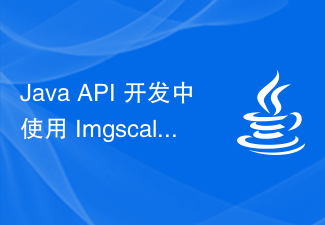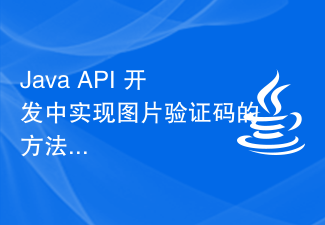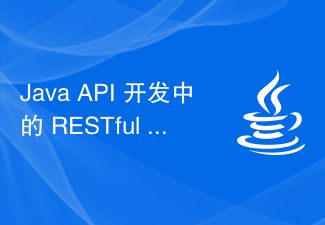In Java development, date processing is a frequently involved issue. The native Java date processing method has some problems in some cases, such as cross-time zone comparison, timestamp conversion, date formatting, etc. To solve these problems, many developers turn to third-party date processing libraries. Among them, Joda-Time is a very popular choice.
Joda-Time is a Java date and time processing class library. It was created by Stephen Colebourne in 2002 to provide a more convenient API than native Java date processing. After years of development, it has become one of the leaders in the field of Java date processing.
If you want to use Joda-Time for date processing in Java API development, you need to perform the following steps first:
1. Download Joda-Time
To use Joda-Time, we first need to download it into our project. You can download the Joda-Time distribution from the official website (http://www.joda.org/joda-time/) or use Maven for dependency management.
<dependency>
<groupId>joda-time</groupId>
<artifactId>joda-time</artifactId>
<version>2.10.7</version>
</dependency>2. Create a DateTime object
In Joda-Time, we use the DateTime object to represent the time in any time zone. We can create DateTime objects through various constructors. Among them, the most common are:
-
DateTime(): Create aDateTimeobject using the current time and time zone -
DateTime (long instant): Create aDateTimeobject using a timestamp - ##DateTime(int year, int monthOfYear, int dayOfMonth, int hourOfDay, int minuteOfHour, int secondOfMinute)
: Create aDateTimeobject using the given year, month, day, hour, minute, second and time zone
DateTimeObject, representing 10:30:00 UTC time on March 30, 2022:
DateTime dateTime = new DateTime(2022, 3, 30, 10, 30, 0, DateTimeZone.UTC);
3. Date operation
In Joda-Time, we can Easily add, subtract, and compare dates. For example, the following code increments .DateTimeField.DAY_OF_MONTH by 1 and returns a newDateTime object:
dateTime = dateTime.plusDays(1);We can also use various methods to compare two
DateTime differences between objects. For example, the following code compares the difference in days between two dates:
DateTime start = new DateTime(2022, 3, 30, 10, 30, 0, DateTimeZone.UTC); DateTime end = new DateTime(2022, 4, 1, 10, 30, 0, DateTimeZone.UTC); int days = Days.daysBetween(start, end).getDays();
4. Formatting dates
Joda-Time provides some built-in formatting tools,DateTime can be formatted as a string. For example, the following code formats a DateTime object into the ISO standard format:
DateTimeFormatter fmt = ISODateTimeFormat.dateTime(); String str = fmt.print(dateTime);In addition to the ISO standard format, Joda-Time also supports custom formatting. For example, the following code formats the
DateTime object into the "yyyy-MM-dd HH:mm:ss" format:
DateTimeFormatter fmt = DateTimeFormat.forPattern("yyyy-MM-dd HH:mm:ss");
String str = fmt.print(dateTime); Overall, Joda-Time provides a powerful and convenient date Processing functions can greatly simplify date processing code in Java API development. Using it can improve the readability and maintainability of the code, making us more efficient and comfortable when processing dates. The above is the detailed content of Using Joda-Time for date processing in Java API development. For more information, please follow other related articles on the PHP Chinese website!
 Java API 开发中使用 Imgscalr 进行图片处理Jun 18, 2023 am 08:40 AM
Java API 开发中使用 Imgscalr 进行图片处理Jun 18, 2023 am 08:40 AMJavaAPI开发中使用Imgscalr进行图片处理随着移动互联网的发展和互联网广告的普及,图片已经成为了很多应用中必不可少的元素。无论是展示商品、构建社交圈、还是增强用户体验,图片都扮演着重要的角色。在应用中,经常需要对图片进行裁剪、缩放、旋转等操作,这就需要借助一些图片处理工具来实现。而Imgscalr则是一个JavaAPI开发中非常常用的图片
 Java API 开发中使用 ZooKeeper 进行分布式锁处理Jun 17, 2023 pm 10:36 PM
Java API 开发中使用 ZooKeeper 进行分布式锁处理Jun 17, 2023 pm 10:36 PM随着现代应用程序的不断发展和对高可用性和并发性的需求日益增长,分布式系统架构变得越来越普遍。在分布式系统中,多个进程或节点同时运行并共同完成任务,进程之间的同步变得尤为重要。由于分布式环境下许多节点可以同时访问共享资源,因此,在分布式系统中,如何处理并发和同步问题成为了一项重要的任务。在此方面,ZooKeeper已经成为了一个非常流行的解决方案。ZooKee
 Java API 开发中实现图片验证码的方法Jun 18, 2023 am 09:22 AM
Java API 开发中实现图片验证码的方法Jun 18, 2023 am 09:22 AM随着互联网技术的快速发展,为了保障系统安全,验证码已经成为了各个系统中必备的一部分。其中,图片验证码依靠着它的易用性和安全性受到开发者们的青睐。本文将介绍在JavaAPI开发中,实现图片验证码的具体方法。一、什么是图片验证码图片验证码是一种通过图片进行人机验证的方式。通常由一张包含数字、字母、符号等的随机组合图片构成,提高了系统的安全性。其工作原理包括
 Java API 开发中的 RESTful 接口设计Jun 18, 2023 am 08:31 AM
Java API 开发中的 RESTful 接口设计Jun 18, 2023 am 08:31 AM随着互联网技术的发展,RESTful风格的API设计成为了最为流行的一种设计方式。而Java作为一种主要的编程语言,也越来越多地在RESTful接口的开发中扮演着重要的角色。在JavaAPI开发中,如何设计出优秀的RESTful接口,成为了一个需要我们深入思考的问题。RESTful接口的基本原则首先,我们需要了解RESTful接口的基本原则。REST即Re
 Java API 开发中使用 Byteman 进行动态代码注入Jun 18, 2023 am 08:03 AM
Java API 开发中使用 Byteman 进行动态代码注入Jun 18, 2023 am 08:03 AMJavaAPI开发中使用Byteman进行动态代码注入在日常的JavaAPI开发中,经常会遇到一些需要进行动态代码注入的场景。动态代码注入可以用于调试、测试和性能分析等方面。在Java开发中,Byteman是一个常用的工具,它提供了一种简单且灵活的方式来进行动态字节码注入。Byteman是一个开源的Java工具,它可以在Java
 Java API 开发中使用 Hutool 进行工具类处理Jun 17, 2023 pm 10:53 PM
Java API 开发中使用 Hutool 进行工具类处理Jun 17, 2023 pm 10:53 PMJava开发人员在进行API开发时,往往需要处理各种工具类,这些工具类可以节省开发时间并且提高代码的可复用性。Hutool是一个Java工具类库,提供了丰富的工具类和常用的算法,能够提高API开发的效率。Hutool支持Java8及以上版本,可以方便地用于各种场景,例如字符串处理、日期时间处理、加密解密、文件操作等等,以下就是一些常用的功能。字符串处理Hut
 PHP和Vue.js开发技巧:如何处理日期和时间数据的统计图表Aug 19, 2023 am 08:10 AM
PHP和Vue.js开发技巧:如何处理日期和时间数据的统计图表Aug 19, 2023 am 08:10 AMPHP和Vue.js开发技巧:如何处理日期和时间数据的统计图表引言:在Web开发过程中,处理日期和时间数据的统计图表是非常常见的需求。PHP和Vue.js的组合是一个强大的工具,可以轻松地处理和展示日期和时间数据的图表。本文将介绍一些有用的技巧和示例代码,帮助读者在开发过程中更好地处理日期和时间数据。一、PHP中的日期和时间处理函数:在PHP中,有一些内置的
 Python 3.x 中如何使用datetime模块进行日期和时间处理Jul 29, 2023 pm 09:53 PM
Python 3.x 中如何使用datetime模块进行日期和时间处理Jul 29, 2023 pm 09:53 PMPython3.x中如何使用datetime模块进行日期和时间处理在Python编程中,经常需要对日期和时间进行处理。Python的datetime模块提供了一些强大的功能,用于处理日期和时间对象。本文将介绍如何使用datetime模块进行日期和时间处理,并给出一些实际的代码示例。导入datetime模块要使用datetime模


Hot AI Tools

Undresser.AI Undress
AI-powered app for creating realistic nude photos

AI Clothes Remover
Online AI tool for removing clothes from photos.

Undress AI Tool
Undress images for free

Clothoff.io
AI clothes remover

AI Hentai Generator
Generate AI Hentai for free.

Hot Article

Hot Tools

Notepad++7.3.1
Easy-to-use and free code editor

MantisBT
Mantis is an easy-to-deploy web-based defect tracking tool designed to aid in product defect tracking. It requires PHP, MySQL and a web server. Check out our demo and hosting services.

DVWA
Damn Vulnerable Web App (DVWA) is a PHP/MySQL web application that is very vulnerable. Its main goals are to be an aid for security professionals to test their skills and tools in a legal environment, to help web developers better understand the process of securing web applications, and to help teachers/students teach/learn in a classroom environment Web application security. The goal of DVWA is to practice some of the most common web vulnerabilities through a simple and straightforward interface, with varying degrees of difficulty. Please note that this software

EditPlus Chinese cracked version
Small size, syntax highlighting, does not support code prompt function

SublimeText3 Linux new version
SublimeText3 Linux latest version






